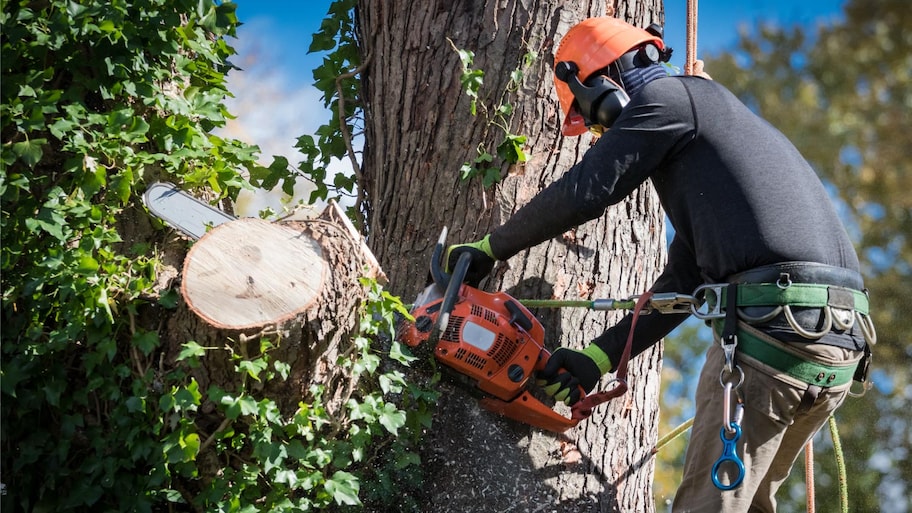Can You Get A Tree Removed For Free? Not Usually
No, it is rarely possible to get a tree cut down for free


Highlights
Free tree removal services are rarely, if ever, possible.
The average cost for tree removal is $750, but can range from $200 to $2,000.
DIY tree removal saves money but can be very unsafe or illegal—it is not recommended.
You can do some prep and cleanup work yourself to save on removal costs.
Whether there's an old maple leaning ominously over your roof or if you're simply tired of an oak raining acorns down on your car, investing in tree removal can be an important task to take on as a homeowner. The cost to remove a tree can range anywhere from $200 to $2,000, and since, well, money doesn't grow on trees, it's understandable to seek out other wallet-friendly options.
In some very specific situations, you might be able to get a rotting tree or a tree that is causing a safety concern removed for free. Here's what to consider if you hope to find professional yet free tree removal.
When Can You Get a Tree Removed for Free?

There are numerous reasons to prioritize removing a tree in the first place: it's impeding your sewer line, it's developed a common tree fungus, or it's structurally unsound, for example. But rarely will a pro remove the tree for free unless it’s a public safety risk.
First things first: we do not recommend breaking out the chainsaw and taking down a tree without looking into local laws and safety precautions first. As we mentioned, tree removal is not a simple DIY. Even though it might be more costly upfront, hiring a pro is the better, safer, and more cost-effective long-term option, as you have a lower risk of the tree growing back and no risk of property damage.
All this aside, free tree removal by a professional may be a viable option if:
The tree sits on town property
Local laws provide assistance for dead or sick tree removal
The tree poses a threat to the road, sidewalks, or public area
Keep in mind this is dependent on your area and local laws. Also, since free tree removal is rare in itself, it’s best not to assume a tree will be removed for free except in unique circumstances.
How to Get a Tree Cut Down for Free
Let's put the DIY route aside for a second and look at free tree removal options with the help of a pro. There are several instances when it is financially beneficial for a utility company, the town, or even a neighbor to take on the cost themselves. Remember that in these cases, your local government will likely select and manage the pro for you (vs. having the homeowner hire pros).
1. Speak With Your Utility Company
The Federal Regulatory Energy Commission (FERC) designated a plan to regulate vegetation—including trees—that poses a threat to power lines or private right-of-way easements. These are areas that allow the utility company to pass utility lines through your private property.
If you suspect your tree could interfere with your town's electricity to do its health or reach its branches, give your local power company a call. They may send an arborist and an energy professional to determine if the tree needs trimming or removal on their dime.
Similarly, tree roots can do a number on sewer lines, particularly on older trees with large root systems. Check with your local public water and sewer service for an inspection—they’ll be able to let you know if your tree needs to be removed.
2. Reach Out to the Town
Your town may also lay out procedures for trees threatening public spaces such as roads and walkways—areas often referred to as public right-of-way areas. If you have a tree leaning toward the road or roots that break through the sidewalk, your town may prefer to have the tree removed, even if it's on your property.
However, these laws vary from town to town. For example, many jurisdictions will only offer free tree removal if the tree in question is dead or causing significant damage—such as lifting the sidewalk.
If the town does not agree to remove the tree for you, remember that you may still need to get the okay to remove it yourself, depending on local laws.
3. Apply for a Grant
Local counties and city governments may also offer grants for tree removal or vegetation management, especially if you live in an area prone to extreme weather or wildfires. There are even some non-profit organizations dedicated to managing safe vegetation in specific regions. Keep in mind that these grants are often very specific, but they’re useful if you live in an area where it would be beneficial to reduce dangerous trees and brush.
4. Check Your Homeowners Insurance
This tip typically pertains to the free removal of trees that have already fallen over. Check your homeowner's insurance plan for tree coverage to see if they will foot the bill for local tree removal and stump grinding services.
In some cases, the tree must have fallen on your house or caused damage on its way down to qualify. The plan may also specify coverage eligibility depending on why the tree fell. Weather-related damage may apply, whereas trying to cut the tree down yourself and damaging your home in the process likely will not.
5. Advertise the Lumber
As a last-ditch effort, consider advertising free firewood or lumber to those willing to pay for the cost of the tree removal. Local neighbors looking for dry, quality firewood may be willing to cover the bill, but again, remember to check with local laws about who they must hire.
In some cases, local lumber supply companies will look for a specific species of wood, especially if it's a large healthy tree or a series of several trees. You may not be allowed to sell the wood in some areas, but this may be an option if the tree poses a threat to your home or a right-of-way area. Watch out for non-certified "pros" offering to remove the tree for you, as this poses an insurance risk if someone gets injured on your property.
Can You DIY Tree Removal?
If you can’t get the tree removed by a professional for free, removing it yourself might seem like a viable, cost-effective solution. But DIY tree removal can be dangerous—or illegal.
Country and local city ordinances may protect the removal of certain species or removal or trees without the help of a licensed professional. Take a look at Orlando's tree ordinances, for example. You must either receive a professional recommendation from a certified arborist or licensed landscape architect or apply for a permit to remove the tree. You may even need to plant a tree in its place.
If your local laws give you the green light and you feel confident with a chainsaw, there are steps to cut down a tree yourself for free—plus the cost of supplies. Some situations where it may be possible to remove the tree yourself include:
The tree is small (under 15 feet).
The tree is in an isolated, open area, away from structures and power lines.
You have the necessary tools and are experienced with using them correctly.
We do not recommend attempting to cut down larger trees that could pose a risk to you, your home, or any surrounding property. Knowing how to remove a tree safely—and when to hire a pro instead—is crucial to avoid injuries or damage to your home. Hiring a tree removal company near you or a local certified arborist can give you the peace of mind that you’re not risking property damage or injury and is more cost-effective in the long term.
How to Save Money on Tree Removal
Since it’s unlikely that you can get a tree removed for free, here are some tips to at least reduce costs:
Remove Trees in the Off-Season: Tree removal services may be cheaper in late winter or early spring when demand is lower.
Clear the Area Yourself: Prepare the area around the tree by removing obstacles like patio furniture, garden decorations, and other items that can slow the removal process.
Dispose of the Debris: Offer to handle the cleanup and debris removal yourself. Some companies charge extra for hauling away tree branches and trunks, so taking on this task can save you money.
Sell or Use the Wood: If the tree is hardwood, you might be able to sell the wood to a lumber company or use it yourself as firewood, offsetting some of the removal cost.
Bundle Tree Services: If you have multiple trees that need to be removed, or need other services like pruning or trimming, bundling them together can get you a better rate.
Frequently Asked Questions
Counties and local municipalities may offer low-cost tree removal programs for seniors. In most cases, the free services apply to dead or dying trees that pose a threat to their home or local utilities, but it's worth reaching out to your local government for more details. Without local approval, most trees cannot be removed free of charge.
Local tree removal prices range from $200 to $2,000 overall, but vary depending on:
Local cost of labor and supplies
Accessibility of the tree
Local laws regarding who is allowed to remove the tree
The species of the tree (softer woods are often easier to remove)
Local seasonal discounts for the off-season
State and local laws vary, but in most cases, you are allowed to trim any branches from your neighbor's tree that cross your property line. However, it's important to ensure you do not damage the overall health of the tree in the process. Removing branches incorrectly can jeopardize the health of the tree and could lead to you being on the hook to replace it.
Some signs that a tree needs to be cut down and removed include:
There’s visible damage to the trunk or branches.
The tree is leaning significantly.
It’s growing too close to a house, power lines, or other structures.
The tree has a pest infestation.

